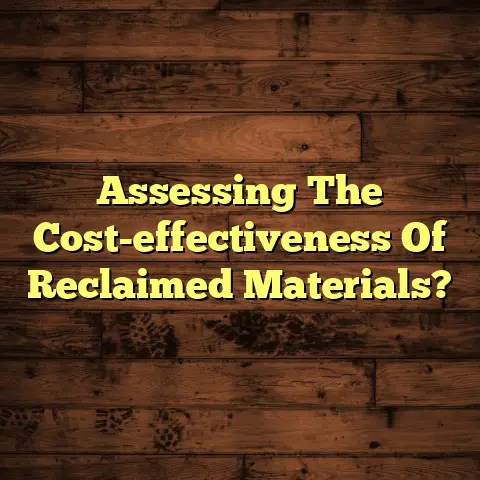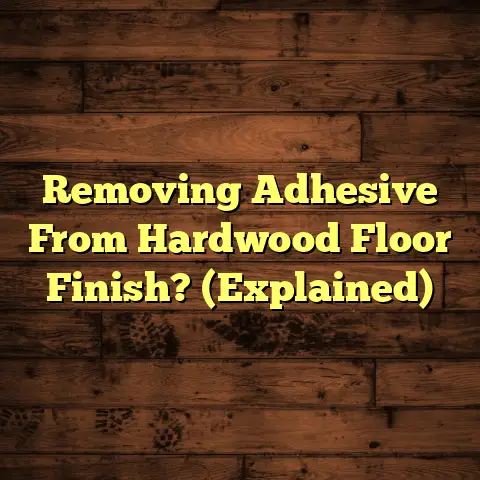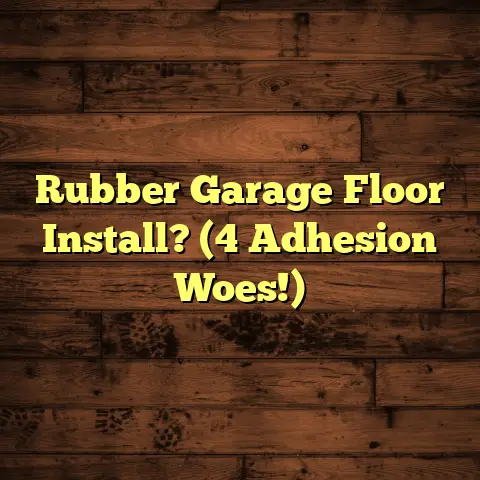Linoleum For Kitchens? (2 Subfloor Risks Exposed!)
Many homeowners believe that linoleum is an outdated and inferior choice for kitchen flooring, relegated to the homes of the past. But, I’m here to tell you that this is a myth!
As a flooring contractor with years of experience, I’ve seen linoleum make a serious comeback. It’s not your grandma’s kitchen floor anymore.
Let’s dive into the world of linoleum and uncover why it’s a fantastic option for modern kitchens, but also expose the critical subfloor risks you absolutely need to know about before you even think about installation.
Section 1: Understanding Linoleum as a Flooring Option
First, let’s get one thing straight: linoleum is not vinyl. I can’t tell you how many times I’ve had to correct people on this one. They’re totally different materials.
So, what is linoleum? It’s a natural flooring material made from renewable resources like linseed oil, rosin, wood flour, cork dust, and mineral pigments. These are pressed onto a jute backing. Pretty cool, right?
Think of it as the original eco-friendly flooring. Because of its natural composition, it’s biodegradable.
You might be surprised to know that linoleum has seen a huge resurgence in contemporary kitchen designs. Gone are the days of limited color options and boring patterns. Now, you can find linoleum in a wide array of colors, patterns, and even textures that mimic stone or wood.
I recently installed a beautiful, vibrant blue linoleum floor in a client’s modern kitchen, and it completely transformed the space. They were thrilled!
Here’s a quick breakdown of linoleum’s key features:
- Natural Materials: Made from renewable resources.
- Durability: Can last for decades with proper care.
- Variety: Available in countless colors and patterns.
- Eco-Friendly: Biodegradable and sustainable.
Section 2: The Kitchen Environment and Linoleum
The kitchen is a unique environment. It’s the heart of the home, but it’s also a high-traffic zone. It demands flooring that can withstand spills, splashes, dropped pots, and constant foot traffic.
When choosing flooring for a kitchen, moisture resistance is crucial. Think about it: dishwashers, leaky faucets, accidental spills – it’s a constant battle against water.
Durability is also key. You need a floor that can handle the wear and tear of daily life without showing scratches, dents, or fading. And let’s not forget ease of cleaning! Who wants to spend hours scrubbing the kitchen floor?
Linoleum really shines in these areas. Its natural composition makes it surprisingly water-resistant. While it’s not waterproof, it can handle everyday spills without absorbing moisture and causing damage.
Plus, linoleum is incredibly durable. A well-maintained linoleum floor can easily last for 20-30 years.
And cleaning? A simple sweep and mop are usually all you need. I’ve had clients tell me that their linoleum floors are easier to clean than their hardwood floors!
Here’s a comparison table highlighting linoleum’s advantages compared to other common kitchen flooring options:
| Feature | Linoleum | Vinyl | Hardwood | Tile |
|---|---|---|---|---|
| Moisture Resistance | Good | Excellent | Poor | Excellent |
| Durability | Excellent | Good | Good | Excellent |
| Ease of Cleaning | Excellent | Excellent | Good | Good |
| Eco-Friendly | Excellent | Poor | Moderate | Moderate |
| Cost | Moderate | Low | High | Moderate to High |
Section 3: The Myth vs. Reality of Linoleum
Let’s revisit that myth: Linoleum is outdated and inferior. Where did this idea even come from?
I think it stems from the perception of old, worn-out linoleum floors in older homes. But, the linoleum of today is vastly different from what was used decades ago.
The manufacturing process has improved, the designs are more sophisticated, and the installation techniques are more advanced.
According to a report by the Resilient Floor Covering Institute (RFCI), linoleum sales have been steadily increasing in recent years, indicating a growing demand for this sustainable and durable flooring option.
I’ve personally seen a huge shift in perception. More and more homeowners are specifically requesting linoleum for their kitchens because they’re looking for eco-friendly and long-lasting options.
I had one client, Sarah, who was initially hesitant about using linoleum. She had the same preconceived notions that it was old-fashioned and cheap. But after I showed her some modern linoleum designs and explained the benefits, she decided to give it a try.
She ended up choosing a beautiful, geometric-patterned linoleum for her kitchen, and she absolutely loves it! She constantly gets compliments on it, and she’s amazed at how easy it is to clean.
“I can’t believe I almost dismissed linoleum,” she told me. “It’s the perfect combination of style, durability, and sustainability.”
Here are some key reasons why the myth is wrong:
- Modern Designs: Linoleum now comes in a wide range of stylish colors, patterns, and textures.
- Improved Manufacturing: Modern linoleum is more durable and resistant to wear and tear.
- Eco-Friendly: Linoleum is a sustainable and biodegradable flooring option.
- Easy Maintenance: Linoleum is easy to clean and maintain, making it ideal for busy kitchens.
Section 4: Subfloor Risks and Linoleum Installation
Okay, now for the crucial part: subfloor risks. You can have the most beautiful, high-quality linoleum in the world, but if your subfloor isn’t properly prepared, you’re going to run into problems.
The subfloor is the foundation upon which your flooring rests. It provides the structural support and stability that your linoleum needs to perform its best.
Think of it like building a house: you can’t build a sturdy house on a weak foundation. The same applies to flooring.
There are two major subfloor risks that you need to be aware of:
- Moisture Issues
- Inadequate Structural Support
Let’s tackle moisture first.
Moisture Issues
Moisture is the enemy of any flooring installation, but it’s especially problematic for linoleum. Why? Because excessive moisture can cause the jute backing of the linoleum to deteriorate, leading to bubbling, warping, and even mold growth. And nobody wants that!
Moisture can come from a variety of sources:
- Leaks: Plumbing leaks, roof leaks, or even condensation can seep into the subfloor.
- High Humidity: In humid climates, moisture can penetrate through the foundation and into the subfloor.
- Improper Ventilation: Poor ventilation can trap moisture underneath the flooring.
I’ve seen countless cases where homeowners installed linoleum without properly addressing moisture issues, and the results were disastrous. Within a few months, the linoleum started to bubble and peel, and they had to replace the entire floor.
It’s a costly and frustrating experience, and it’s completely avoidable.
Mold and mildew are also serious concerns. Moisture creates the perfect breeding ground for these unwanted guests, which can not only damage your flooring but also pose health risks to you and your family.
Inadequate Structural Support
The second major subfloor risk is inadequate structural support. Linoleum needs a solid, stable base to prevent cracking, buckling, and premature wear.
If your subfloor is weak, uneven, or damaged, it won’t be able to properly support the linoleum, and you’ll start to see problems.
Common causes of inadequate structural support include:
- Damaged Subfloor: Cracks, holes, or rot in the subfloor can compromise its structural integrity.
- Uneven Subfloor: An uneven subfloor can create stress points in the linoleum, leading to cracking and buckling.
- Inadequate Thickness: A subfloor that is too thin may not be able to support the weight of the linoleum and the foot traffic.
I once worked on a project where the homeowner had installed linoleum over an old, termite-infested subfloor. Needless to say, the linoleum didn’t last very long. The termites continued to eat away at the subfloor, causing the linoleum to crack and crumble.
It was a messy and expensive situation, and it could have been prevented with a proper subfloor inspection and repair.
Section 5: Addressing Subfloor Risks
So, how do you protect yourself from these subfloor risks? It all starts with a thorough assessment before you install your linoleum.
Here’s a step-by-step guide:
-
Visual Inspection: Carefully inspect the subfloor for any signs of damage, such as cracks, holes, rot, or stains. Pay close attention to areas around plumbing fixtures and exterior walls, where moisture is more likely to accumulate.
-
Moisture Testing: Use a moisture meter to check the moisture content of the subfloor. The acceptable moisture level will depend on the type of subfloor, but generally, you want it to be below 12%. You can find moisture meters at most hardware stores.
-
Levelness Check: Use a level and a straightedge to check the levelness of the subfloor. Any significant dips or humps will need to be addressed before installing the linoleum.
-
Stability Test: Walk around on the subfloor and feel for any soft spots or movement. If the subfloor feels unstable, it may need to be reinforced or replaced.
If you identify any issues during your assessment, don’t panic! There are several preventive measures you can take to mitigate moisture and structural problems:
-
Vapor Barriers: Install a vapor barrier over the subfloor to prevent moisture from rising up and damaging the linoleum. This is especially important in basements or crawl spaces. I recommend using a 6-mil polyethylene vapor barrier.
-
Proper Ventilation: Ensure that your kitchen has adequate ventilation to prevent moisture buildup. This may involve installing exhaust fans or opening windows regularly.
-
Subfloor Repair: Repair any cracks, holes, or rot in the subfloor before installing the linoleum. You can use wood filler, patching compound, or plywood to repair damaged areas.
-
Subfloor Reinforcement: If the subfloor is weak or unstable, you may need to reinforce it with additional layers of plywood or concrete board.
-
Self-Leveling Compound: If the subfloor is uneven, you can use a self-leveling compound to create a smooth, level surface for the linoleum.
I always tell my clients: “It’s better to spend a little extra time and money on subfloor preparation than to risk having to replace your entire floor down the road.”
Section 6: Conclusion
Linoleum is a fantastic kitchen flooring option that offers a unique blend of style, durability, and sustainability.
Don’t let outdated myths and misconceptions prevent you from considering this versatile and eco-friendly material.
But, remember, a successful linoleum installation depends heavily on proper subfloor preparation.
Understanding and addressing subfloor risks like moisture issues and inadequate structural support is crucial for ensuring a long-lasting and beautiful linoleum floor.
So, before you embark on your kitchen flooring project, take the time to assess your subfloor, implement preventive measures, and ensure that you have a solid foundation for your new linoleum floor.
I hope this article has helped you reconsider the potential of linoleum and given you the knowledge you need to create a stylish, durable, and functional kitchen space that you’ll love for years to come!
Don’t be afraid to embrace the comeback of linoleum. With the right preparation and installation, it can be a truly outstanding choice for your kitchen.





